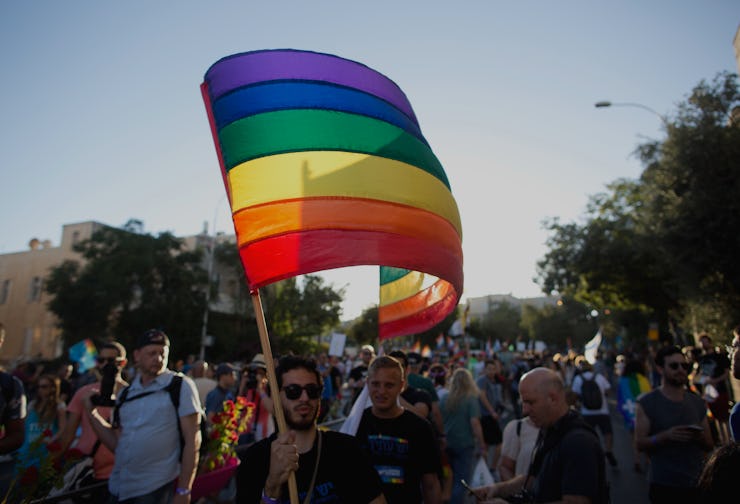Why the Term "Safe Sex" Is Being Replaced by "Healthysexual"
A new campaign looks to change the way we talk about sex.

To anyone who grew up with the language of 1980s and 1990s PSAs, the term “safe sex” won’t raise any concerns. At the time, posters, TV advertisements, and radio spots tackled, with conservative frankness, the rampant and deadly spread of HIV. “Safe sex”, modern critics now believe, suggested that many sexual activities, specifically non-heteronormative ones, were unsafe by definition. This heightened stigma around the sexual acts of queer people.
So, in 2017, “safe sex” is now an anachronism.
The new “Healthysexual” campaign says the term “safe sex” has outlived its use, and that it further perpetuates fearing and judging people based on their chosen sexual activities. While the concept of “safety” is, correctly, bound to pregnancy prevention, condom usage, and HIV/AIDS awareness, this new campaign puts the focus on how following those guidelines improves makes a person more or less healthy, not more or less safe.
It’s an argument about semantics, but it’s still an important one to understand in 2017. The term “safe sex” was borne out of a time when an HIV diagnosis seemed an unavoidable death sentence, but now that the virus is treatable, concerns around sex are a question of maintaining health and not avoiding danger. There’s a lot less stigma associated with being unhealthy than there is with being unsafe. One could make a comparison between “healthy sex” and the push among psychiatrists in the 1960s to say “mental health” or “mental hygiene” rather than condemning people with “mental illness”.
Healthysexual, which launched in December 2016 but is back in the spotlight as New York City and San Francisco gear up to celebrate Pride, is “all about taking charge of your sexual health.” The campaign’s colorful Tumblr speaks the language of the internet, advocating for testing, discussing prevention, and highlighting awareness techniques via GIFs and funny, informative illustrations, many of which have been co-signed by the American Sexual Health Association. The tone is pretty straight-forward without being outright clinical, and any irony is followed by a helpful correction or fact. One guide on the site is labeled “The Birds and the Baes.”
Anyone with an internet connection can access the campaign’s wealth of information at their leisure and not feel judged while doing so — a huge shift from the uncomfortable experience of watching a fear-raising PSA. The campaign is unabashed in its celebration of non-heterosexual groups, and it seems most keen on communicating pride and advice to minority groups of many stripes: sexual, racial, economic. “Congrats on the sex!” the campaign exclaims. “Let’s just make sure you and your partner are doing it hot and healthily.* The word “safe” is nowhere to be seen.
The team behind Healthysexual aren’t the only people who have reconsidered “safe”‘s association with fear.
Planned Parenthood, acknowledging the problems the term “safety” raises, prefers “safer sex,” which it labels as “protecting yourself and your partners from sexually transmitted infections. Safer sex helps you stay healthy and can even make sex better.” New York City’s HIV-focused “Playsure” campaign has replaced “safe” with being “sure” about your HIV status. A Los Angeles LGBT Centre campaign promoting the anti-HIV PReP drugs tackled the term’s unwanted connotations with fear head-on by launching a campaign called “F*ck w/out Fear.”
But Healthysexual is the first to bring the focus to health. The point of sex ed, now, isn’t “to defend, to ward off, or to be clear of danger,” as being “safe” has historically meant. Rather, it’s to teach people to be both amorous and healthy. Thus, Healthysexual. The campaign takes strides beyond the notion of “safe” by promoting habits and best practices that will make sex talk into a hot part of the whole process, and less an academic or protracted distraction. “It’s about getting informed, communicating, and choosing the right protection so you can be yourself. Whatever you’re into,” the campaign website reads.
Healthysexual’s campaign is a rejoinder to the safe sex courses that countless American teens are still prescribed. It isn’t that sexual education courses are bad or unproductive; it’s just that they’re out of touch — especially ones which use abstinence-only curriculums. Those have been proven multiple times to be completely ineffective, and yet the practice persists. Popularly mocked for their stereotypically misguided or clueless approach to talking about sex, most sex education materials could definitely be improved.
We live in a world that’s graduated, partially, from the initial shock of the AIDS crisis — one where sexual identities and preferences are continually being welcomed into the mainstream. The sexual mores of prior time periods offer cautionary tales, but they don’t speak to millennials in a way that helps them understand that the best sex is healthy sex. Our attitudes, technologies, and apprehension about sex have changed since the term “safe sex” was coined. Why shouldn’t our language follow suit?